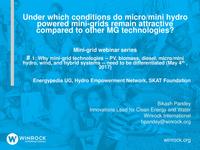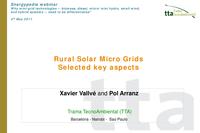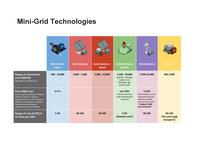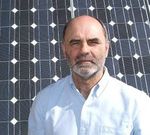Difference between revisions of "Mini-grid Webinar Series"
***** (***** | *****) m |
***** (***** | *****) m |
||
| Line 1: | Line 1: | ||
{| style="width: 100%" class="FCK__ShowTableBorders" cellspacing="1" cellpadding="1" border="0" | {| style="width: 100%" class="FCK__ShowTableBorders" cellspacing="1" cellpadding="1" border="0" | ||
|- | |- | ||
| − | | style="width: 85%; | + | | style="width: 85%; border-bottom: 2px solid rgb(151, 191, 13); vertical-align: bottom; text-align: center" | |
| − | <span style="color: rgb(72,177,69); | + | <span style="color: rgb(72,177,69); font-size: 30px">'''Mini-Grids Webinar Series'''</span><br/> |
|} | |} | ||
Renewable energy mini-grids are a widely discussed solution for cost-effective and reliable energy access. However, within the mini-grids dialogue micro and mini hydropower (MHP)<sup>1</sup> is often overlooked, despite the large number of beneficial projects operating globally, particularly in rural regions of Asia, Africa, and Latin America.<br/> | Renewable energy mini-grids are a widely discussed solution for cost-effective and reliable energy access. However, within the mini-grids dialogue micro and mini hydropower (MHP)<sup>1</sup> is often overlooked, despite the large number of beneficial projects operating globally, particularly in rural regions of Asia, Africa, and Latin America.<br/> | ||
| − | + | <span class="mw-customtoggle-PractitionerWorkshop-10November2014" style="font-size:small; font-weight: bold; display:inline-block; float:right; color: blue"><span class="mw-customtoggletext">read more</span></span> | |
| − | |||
<div id="mw-customcollapsible-PractitionerWorkshop-10November2014" class="mw-collapsible mw-collapsed"> | <div id="mw-customcollapsible-PractitionerWorkshop-10November2014" class="mw-collapsible mw-collapsed"> | ||
| + | Many MHP systems originated as water mills that were upgraded to generate electricity (e.g. Afghanistan, Pakistan, and northern India). Some have transitioned from isolated mini-grids to grid-interconnected systems (e.g. Indonesia and Sri Lanka). As a proven technology with a long track record, micro/mini hydropower is the focus of this webinar series, which will also analyze similarities and differences among the various mini-grid technologies. | ||
Each webinar in the series will focus on a distinct and relevant topic, namely '''Technology Differentiation, Grid-Interconnection, and Productive End Use'''. | Each webinar in the series will focus on a distinct and relevant topic, namely '''Technology Differentiation, Grid-Interconnection, and Productive End Use'''. | ||
| Line 21: | Line 21: | ||
[1] In this context, micro hydropower refers to <100kW, and mini hydropower refers to 100 - 1000 kW (or 1MW).<br/> | [1] In this context, micro hydropower refers to <100kW, and mini hydropower refers to 100 - 1000 kW (or 1MW).<br/> | ||
</div> | </div> | ||
| + | |||
| + | |||
= 1st Webinar: Technology Differentiation = | = 1st Webinar: Technology Differentiation = | ||
| − | <p style="text-align: center">'''<span style="color: rgb(72,177,69); | + | <p style="text-align: center">'''<span style="color: rgb(72,177,69); font-size: 15px">Webinar: Why mini-grid technologies -- PV, biomass, diesel, micro/mini hydro, wind, and hybrid systems -- need to be differentiated.</span>'''</p><p style="text-align: center"><font color="#48b145"><span style="font-size: 15px;">'''Webinar Recording'''</span></font></p><br/> |
| − | |||
| − | + | {{#widget:YouTube|id=Yc9OLiGW52I|height=300|width=600}} | |
| − | |||
| − | |||
| − | + | This webinar will highlight the important technical and non-technical features, as well as pros and cons of different technologies to create awareness on the need for differentiation of mini-grid systems.<span style="font-size: 0.85em; text-align: center;"> </span> | |
| − | + | <br/> | |
| − | |||
| − | |||
| − | + | == Download the Presentations == | |
| + | |||
| + | {| | ||
| + | |- | ||
| + | | [[File:Presentation Bikash.pdf|thumb|200px|Bikash Pandey|link=https://energypedia.info/images/8/83/Presentation_Bikash.pdf]] | ||
| + | | [[File:Vallvé Presentation.pdf|thumb|200px|Xavier Vallvé and Pol Arranz Presentation|link=https://energypedia.info/images/e/ea/Vallv%C3%A9_Presentation.pdf]] | ||
| + | | [[File:Mini-grid Technology Comparison.pdf|thumb|200px|Mini-grid Technology Comparison|link=https://energypedia.info/images/a/ad/Mini-grid_Technology_Comparison.pdf]] | ||
| + | |} | ||
== Speakers == | == Speakers == | ||
| Line 66: | Line 70: | ||
| style="width: 176px" | | | style="width: 176px" | | ||
[[File:Picture Pol.png|left|150px|alt=Picture Pol.png|link=Mini-grid Webinar Series]] | [[File:Picture Pol.png|left|150px|alt=Picture Pol.png|link=Mini-grid Webinar Series]] | ||
| + | |||
| style="width: 566px" | | | style="width: 566px" | | ||
'''Pol Arranz-Piera''' has over 17 years experience in renewable energy engineering and consultancy projects. Since 2002 he has been working for Trama TecnoAmbiental, where he currently serves as Projects Director, dealing with projects in the field of rural electrification. He also collaborates as an Associate Researcher at the Technical University of Catalonia (UPC). His academic work focuses on the development of distributed energy generation planning methodologies, supply chains and small scale bioenergy and solar systems. Mr Arranz-Piera has worked in off grid minigrids since 2004 in Perú, Ecuador, Nicaragua, Ivory Coast, Costa Rica, Paraguay, Morocco, Guinea Bissau, Burkina Faso, Sierra Leone, Kenya, and is currently supervising the GEDAP pilot minigrid project in Ghana. | '''Pol Arranz-Piera''' has over 17 years experience in renewable energy engineering and consultancy projects. Since 2002 he has been working for Trama TecnoAmbiental, where he currently serves as Projects Director, dealing with projects in the field of rural electrification. He also collaborates as an Associate Researcher at the Technical University of Catalonia (UPC). His academic work focuses on the development of distributed energy generation planning methodologies, supply chains and small scale bioenergy and solar systems. Mr Arranz-Piera has worked in off grid minigrids since 2004 in Perú, Ecuador, Nicaragua, Ivory Coast, Costa Rica, Paraguay, Morocco, Guinea Bissau, Burkina Faso, Sierra Leone, Kenya, and is currently supervising the GEDAP pilot minigrid project in Ghana. | ||
| Line 88: | Line 93: | ||
= 2nd Webinar: Grid-Interconnection = | = 2nd Webinar: Grid-Interconnection = | ||
| − | <p style="text-align: center">'''<span style="color: rgb(72,177,69); | + | <p style="text-align: center">'''<span style="color: rgb(72,177,69); font-size: 15px">Webinar: Grid interconnection of micro/mini hydro mini-grids: What happens when the national grid arrives?</span>'''</p><p style="text-align: center"><font color="#48b145"><span style="font-size: 15px">'''Date: June 1, 2017'''</span></font></p><p style="text-align: center"><font color="#48b145">'''Time: Forthcoming'''</font><br/></p><p style="text-align: center"><font color="#48b145">'''Registration Link: Forthcoming'''</font><br/></p><p style="text-align: center"><br/></p> |
As governments worldwide prioritize rural electrification, an increasing number of mini-grids built for rural communities are facing the “question” of what happens to the mini-grid when the national grid arrives. Whether this is a serious problem or rather a big opportunity for the community will depend on a number of parameters.<br/> | As governments worldwide prioritize rural electrification, an increasing number of mini-grids built for rural communities are facing the “question” of what happens to the mini-grid when the national grid arrives. Whether this is a serious problem or rather a big opportunity for the community will depend on a number of parameters.<br/> | ||
| Line 115: | Line 120: | ||
= 3rd Webinar: Productive End Use = | = 3rd Webinar: Productive End Use = | ||
| − | <p style="text-align: center">'''<span style="color: rgb(72,177,69); | + | <p style="text-align: center">'''<span style="color: rgb(72,177,69); font-size: 15px">Webinar: Productive End Use -- Three examples of how to make it happen.</span>'''</p><p style="text-align: center"><font color="#48b145"><span style="font-size: 15px">'''Date: Early July'''</span></font></p><p style="text-align: center"><font color="#48b145">'''Time: Forthcoming'''</font><br/></p><p style="text-align: center"><font color="#48b145">'''Registration link: Forthcoming'''</font><br/></p><p style="text-align: center"><br/></p> |
Once implemented mini-grids need to be financially sustainable. Their operation and maintenance costs are recovered from tariffs, which depend on power consumption. Providing only lighting is a missed opportunity to bring optimal impact to economically marginalized rural communities. Micro/mini hydropower can generate many kWh's -- we need to learn how to make use of them! | Once implemented mini-grids need to be financially sustainable. Their operation and maintenance costs are recovered from tariffs, which depend on power consumption. Providing only lighting is a missed opportunity to bring optimal impact to economically marginalized rural communities. Micro/mini hydropower can generate many kWh's -- we need to learn how to make use of them! | ||
Revision as of 21:11, 4 May 2017
|
Mini-Grids Webinar Series |
Renewable energy mini-grids are a widely discussed solution for cost-effective and reliable energy access. However, within the mini-grids dialogue micro and mini hydropower (MHP)1 is often overlooked, despite the large number of beneficial projects operating globally, particularly in rural regions of Asia, Africa, and Latin America.
read more
Many MHP systems originated as water mills that were upgraded to generate electricity (e.g. Afghanistan, Pakistan, and northern India). Some have transitioned from isolated mini-grids to grid-interconnected systems (e.g. Indonesia and Sri Lanka). As a proven technology with a long track record, micro/mini hydropower is the focus of this webinar series, which will also analyze similarities and differences among the various mini-grid technologies. Each webinar in the series will focus on a distinct and relevant topic, namely Technology Differentiation, Grid-Interconnection, and Productive End Use.
The objectives of this webinar series are to strengthen the sector by:
- facilitating exchange among field practitioners, regional and international experts
- creating awareness on up-to-date developments, barriers and opportunities.
[1] In this context, micro hydropower refers to <100kW, and mini hydropower refers to 100 - 1000 kW (or 1MW).
1st Webinar: Technology Differentiation
Webinar: Why mini-grid technologies -- PV, biomass, diesel, micro/mini hydro, wind, and hybrid systems -- need to be differentiated.
Webinar Recording
This webinar will highlight the important technical and non-technical features, as well as pros and cons of different technologies to create awareness on the need for differentiation of mini-grid systems.
Download the Presentations
Speakers
|
Bikash Pandey is Director of Innovations for the Clean Energy, Environment and Water group at Winrock International. Pandey’s work experience encompasses 20 years in policy review, design and implementation of a range of clean/renewable energy projects in Africa, Latin America and Asia. A technical specialist in micro- and mini-hydropower systems, he has designed and implemented numerous community-based electrification, clean transportation projects, small-scale mini-grids, and home energy systems. He has extensive experience in developing small-scale renewable energy projects as activities under the Clean Development Mechanism. He also brings experience encouraging policy change within governments, bilateral and multilateral donors to support clean energy. He holds a master’s in energy and resources from the University of California at Berkeley, and a bachelor’s in electrical engineering from MIT. | |
|
Xavier Vallvé holds engineering and Master’s degrees from the University of Waterloo in Canada and is co-founder and director of the engineering and consultancy firm Trama TecnoAmbiental (TTA) in Barcelona, Spain. He has more than 25 years of experience in renewable energy rural electrification and distributed generation projects, autonomous as well as grid tied, RE hybrid technology for islands and isolated villages. This involves complementary interdisciplinary activities in economic, social and management aspects as well as engineering in RE generation and storage. He has been project director or lead consultant for private and government clients and also for projects by UNDP, UNOPS, UNIDO, UNEP, AECID, IDB, WB, EC, IRENA and other agencies. He is director and lecturer of the Master degree “Master en Ingeniería y Gestión de las Energías Renovables” at IL3 (University of Barcelona). | |
Additional Resource Person | |
|
Pol Arranz-Piera has over 17 years experience in renewable energy engineering and consultancy projects. Since 2002 he has been working for Trama TecnoAmbiental, where he currently serves as Projects Director, dealing with projects in the field of rural electrification. He also collaborates as an Associate Researcher at the Technical University of Catalonia (UPC). His academic work focuses on the development of distributed energy generation planning methodologies, supply chains and small scale bioenergy and solar systems. Mr Arranz-Piera has worked in off grid minigrids since 2004 in Perú, Ecuador, Nicaragua, Ivory Coast, Costa Rica, Paraguay, Morocco, Guinea Bissau, Burkina Faso, Sierra Leone, Kenya, and is currently supervising the GEDAP pilot minigrid project in Ghana. | |
Moderator
|
Hedi Feibel is a Renewable Energy and Water Expert at the Swiss Resource Centre and Consultancies for Development (Skat). She has worked for 25 years on assignments in Africa, Asia, the Caribbean and Europe with strong focus on mini and small hydropower. As an energy specialist and hydrologist, she is committed to knowledge transfer and participatory approaches to build up local know-how for the improvement of living conditions. She holds a PhD from the Department of Civil Engineering (Hydrology and Water Management) and Department of Political Economy, Darmstadt University of Technology, Germany. She holds a MSc in Geography / Hydrology, from the Institute of Hydrology, University of Freiburg, Germany. |
2nd Webinar: Grid-Interconnection
Webinar: Grid interconnection of micro/mini hydro mini-grids: What happens when the national grid arrives?
Date: June 1, 2017
Time: Forthcoming
Registration Link: Forthcoming
As governments worldwide prioritize rural electrification, an increasing number of mini-grids built for rural communities are facing the “question” of what happens to the mini-grid when the national grid arrives. Whether this is a serious problem or rather a big opportunity for the community will depend on a number of parameters.
Grid interconnection of micro and mini hydropower (MHP) has emerged as an important topic in south and southeast Asia, driven by several factors:
- MHP facility owners need for long-term certainty in cases where the national grid is expanding into areas where isolated MHP mini-grids operate
- net metering, feed-in tariffs (FiT’s) and other policies and regulatory frameworks that support grid interconnected renewable energy
- MHP’s ability to provide inexpensive renewable energy 24-hours a day, and the grid’s ability to absorb this electricity even at times of day (or night) when local loads are low
- country targets for increased domestic renewable energy production, lower carbon footprints, and increased electricity access.
This second webinar in the series will include:
- examples from Indonesia and Sri Lanka where micro hydropower systems have been successfully connected to the national grid and even benefited the local community
- country experts will describe how micro hydropower developed in their country, what happened when the grid arrived, as well as the current conditions for grid interconnection (e.g. feed-in tariff, technical requirements and economic aspects).
Speakers
- Chayun Budiono, PT Gerbang Multindo Nusantara, Indonesia
- Kapila Subasinghe, Vice President, DFCC Bank, Sri Lanka
Moderator
- To be announced
3rd Webinar: Productive End Use
Webinar: Productive End Use -- Three examples of how to make it happen.
Date: Early July
Time: Forthcoming
Registration link: Forthcoming
Once implemented mini-grids need to be financially sustainable. Their operation and maintenance costs are recovered from tariffs, which depend on power consumption. Providing only lighting is a missed opportunity to bring optimal impact to economically marginalized rural communities. Micro/mini hydropower can generate many kWh's -- we need to learn how to make use of them!
Productive End Use (PEU) of energy refers to activities that increase income or productivity in different sectors such as agriculture (e.g. irrigation, grain milling), manufacturing (e.g. carpentry, welding, and sewing), and the service sector (e.g. restaurants using electric lights, sound systems, refrigerators, mobile charging stations).
This third webinar in the series will focus on PEU of mini/micro hydropower systems. It will examine:
- the social and technical pre-conditions, such as load management and technical reliability, and options such as mechanical drive for agricultural processing
- the increase of load factor through PEU and corresponding increase of the economic viability of the system
- three examples of systems promoting productive end use in different countries. It will present pros and cons of electrifying "existing activities” versus “new businesses”.
<headertabs></headertabs>
Organizers
| Energypedia UG is a non-profit organization that runs and maintains the wiki-based platform, www.energypedia.info. Energypedia.info is an online platform for collaborative knowledge exchange on renewable energy, energy efficiency and energy access in the context of development cooperation. | |
|
|
The Hydro Empowerment Network (HPNET) is a knowledge exchange and advocacy platform for micro/mini hydro practitioners in south and southeast Asia, focusing on policy, technology, and socio-environment solutions for long-term sustainability. Core support for HPNET comes from the WISIONS initiative at the Wuppertal Institute for Climate, Environment and Energy. |
|
|
Skat Foundation was established by Skat Consulting in 2002 to foster the exchange of knowledge and experience in development cooperation through generating, sharing and transferring knowledge about what works and how in selected thematic areas. Skat Foundation has also funded this webinar series. |





























